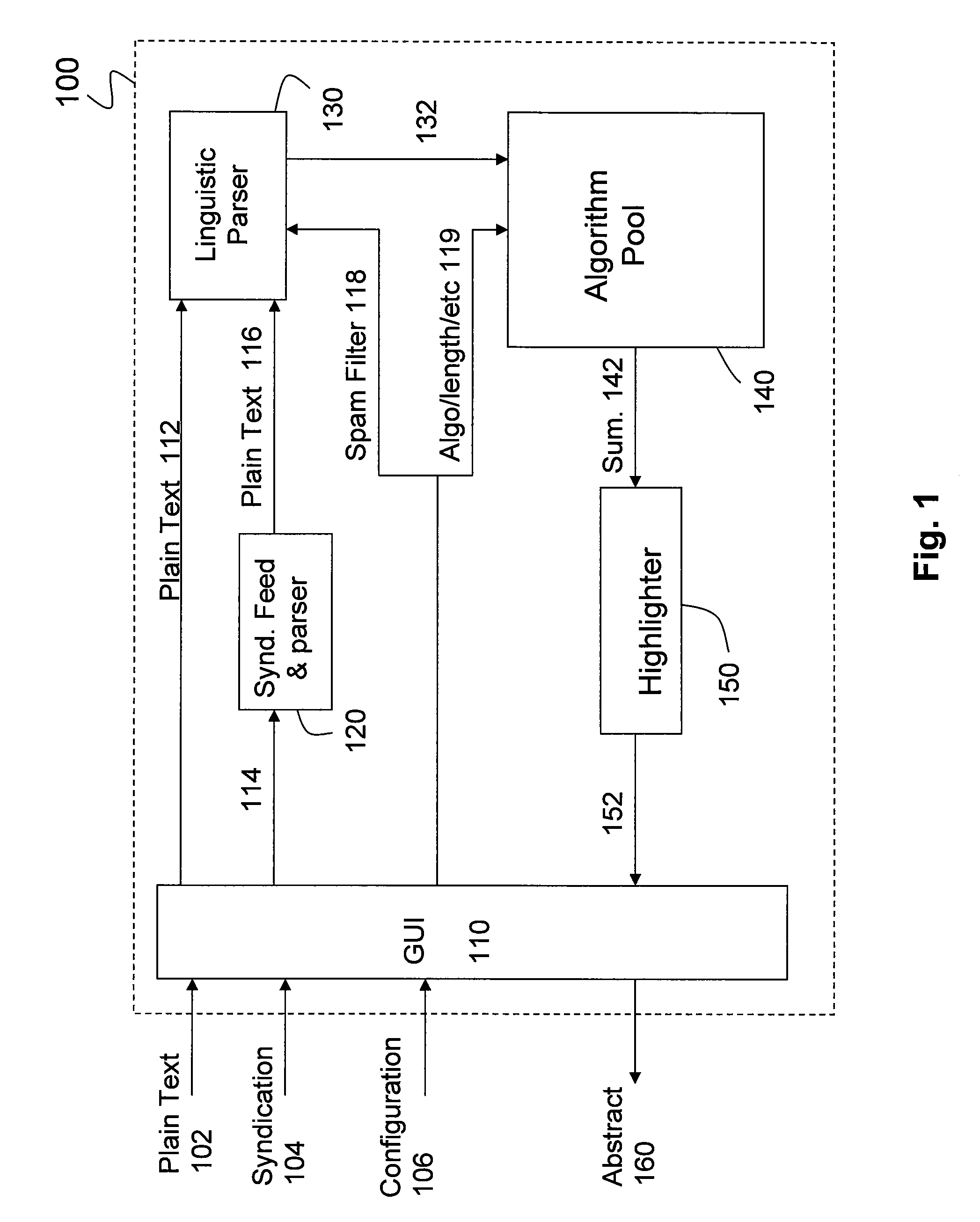Method and apparatus for highlighting diverse aspects in a document
a document and diverse technology, applied in the field of document summary, can solve the problems of tedious and often annoying task of going through all the reviews, and conventional summarization methods do not address coverage and orthagonality
- Summary
- Abstract
- Description
- Claims
- Application Information
AI Technical Summary
Benefits of technology
Problems solved by technology
Method used
Image
Examples
experiment 1
[0046]The goal of the experiments was to evaluate summaries produced according to the principles disclosed herein as compared with conventional algorithms including SVD, K-median and Furthest with respect to coverage and orthogonality. Test data from a 2002 Document Understanding Conference (“DUC”) was obtained. The dataset will be referred to as the DUC dataset. The DUC data consisted of new articles about different events ranging from natural disasters, everyday pieces of news and biographical information about individuals. At a high level the base documents (interchangeably, documents) of the dataset are organized into document clusters. The dataset consisted of 57 such clusters and every cluster contained 5-15 documents. There were, on average, 10 documents per cluster. Each one of the clusters belonged to one of the following thematic categories: C1-C4.
[0047]C1—The documents in a cluster belonging to C1 refer to a single natural disaster event. For example, all the documents wi...
experiment 2
[0060]The goal of this experiment was to compare the automatically-generated summaries produced by the Exp. function, Uniform function, SVD, k-median and Furthest to the pre-existing human-generated summaries Human1 and Human2. For this experiment the ClusteredDUC dataset was used. The results of the experiment demonstrate that the Exp function and the Uniform function produced results that are very close to the human-generated summaries.
[0061]The Evaluation metric was as follows: human-generated summary H was compared with a computer-generated summary S by taking the average closeness of every sentence h ε H to its closest sentence in the computer-generated summary. Closeness between two sentences is evaluated by the size of their intersection. The larger the intersection between two sentences, the closer these two sentences. In other words, the higher the value of closeness the more similar the two summaries H and S are. This is shown at Equation 5, as follows:
[0062]Closeness(H,S...
experiment 3
[0064]Experiment 3 reports the results of a user study in which human subjects were asked to evaluate the human-generated and the computer-generated summaries and rank the results according to certain criteria. The experiment were performed for ten different clusters; that is, 10 documents from the ClusteredDUC dataset. The 10 documents were chosen randomly among the 57 documents available. Each document was evaluated by at least 5 and up to 8 evaluators. There were 21 human evaluators that judged the summaries. Therefore, each algorithm was evaluated from 50 up to 80 times.
[0065]For each evaluation, the evaluators were provided with a document from the ClusteredDUC dataset, and with six different summaries. Four of the summaries were produced by algorithms the Exp function, SVD, K-median and Furthest, while the other two were the summaries from Human1 and Human2. For all the summaries k=10, since for this value of k the actual human-generated summaries were available. For each docu...
PUM
 Login to View More
Login to View More Abstract
Description
Claims
Application Information
 Login to View More
Login to View More - R&D
- Intellectual Property
- Life Sciences
- Materials
- Tech Scout
- Unparalleled Data Quality
- Higher Quality Content
- 60% Fewer Hallucinations
Browse by: Latest US Patents, China's latest patents, Technical Efficacy Thesaurus, Application Domain, Technology Topic, Popular Technical Reports.
© 2025 PatSnap. All rights reserved.Legal|Privacy policy|Modern Slavery Act Transparency Statement|Sitemap|About US| Contact US: help@patsnap.com



